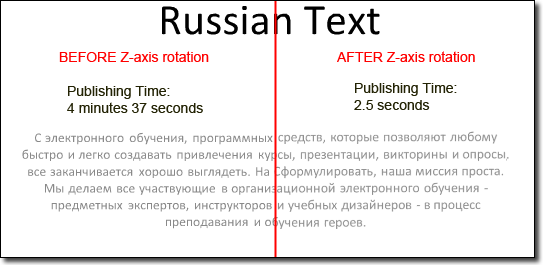Although this article refers specifically to lengthy presentations, this should also allow you to publish right-to-left languages!
To skip the ugly detail and get right to the solution, click here.
It’s not uncommon for presentations with a large number of slides to take longer to publish than a presentation with fewer slides. However, on occasion you might notice some slides take much longer. Why?
When selecting the Publish button from Articulate Presenter there are many functions that start processing, converting and temporarily storing every object, character and audio wave; all of which are later combined into a single .swf file. This set of operations is reset for every slide in the presentation, continuing to create a new .swf for each slide until every object is processed. Depending on drive fragmentation, available space and other system resources, publishing times can vary greatly on different machines. If resources are taxed this could impact performance, sometimes forcing Presenter to close or stop responding.
So what can be done to help get those stubborn PowerPoint projects to publish in Articulate Presenter?
1. Although it’s not always an option, it’s sometimes better to split a large project or a project with a large number of slides into several smaller projects. Each presentation can be linked to the other with a “click here to continue” hyperlink or button. This in effect allows the student or viewer to take a short intermission before continuing on. In addition, smaller projects helps to keep the project size manageable. Having to republish a 300 presentation just to fix a single spelling error can easily turn into an hour long process. This isn’t a good use of time. So remember, keep it manageable for you and your students. Fewer slides require less read/writes to the system drive and therefore increases the probability for a successful publish.
2. Whenever possible, combine slide objects, text and shapes into a single group, save as an image and replace the group with the saved image. As stated above, every object on the slide must be processed, compressed and stored. So why not combine everything that is not animated into a single image? Depending on the number of objects per slide, this can decrease publishing times 10 fold, saving on drive space and greatly increasing the probability for a successful publish.
3. Every letter or character (one by one) is converted and stored as a vector format. This allows the text to scale without affecting quality (sharpness). With Non-Western languages or complex fonts, this conversion can slow publishing times significantly. Converting text to an image and replacing will remove the ability to further edit the text but will significantly decrease publishing times.
Did you know if you rotate a PowerPoint text box on the z-axis by .1 degrees, this, in effect, will be treated as an image when published by Articulate Presenter?
Rotating an object or text box has a minimum effect on the quality and keeps the text in an editable format. This is a great option for projects that contain a large amount of non-western text or complex fonts. A sample side by side screen shot is shown below to help illustrate the publishing quality and publishing time difference.

So to reiterate, the above text prior to rotating on the Z- axis, took 4 minutes and 23 seconds to publish. The rotated text took only 2.5 seconds. WOW!
To demonstrate how rotating a text box on the Z-axis works, I created the Screenr below.
Although this workaround is great, it could take some time to implement for large PowerPoint presentations.
In comes the OptimizeMyPreso.pptm macro!
This macro-enabled PowerPoint file applies the above noted .1 Z-axis rotation to every text box in a PowerPoint presentation and is done with a single mouse click. Please watch the Screenr below to learn how to apply this automated workaround to your PowerPoint projects.
Usage:
The instructions below are for PowerPoint 2007/2010 only.
*** IMPORTANT ***
Always backup your original PowerPoint file before applying any macro. There is a known issue where Articulate Presenter will ignore text box animations that have a 3-D Rotation applied. To work around this issue, where needed, this Macro will apply a 100% Transparent Fill to the text box but could affect how some animations work.
1 . Make sure the PowerPoint Developer Ribbon is enabled. View the following link for instructions on how to enable this. (http://msdn.microsoft.com/en-us/library/bb608625.aspx)
2. Open the OptimizeMyPreso.pptm file and allow Macros if prompted. (Security Warning –> Options… –>Enable this content)
3. With the OptimizeMyPreso.pptm file still open, select the Open menu and locate the problematic PowerPoint file.
4. If it is not already in pptx format, save the problematic file as a .pptx (PowerPoint 2007 or greater).
Note: This Macro will not work for PowerPoint files saved as any other version. If your file has a .ppt extension please save as a .pptx. I also recommend saving the file with a new name. This will ensure you a have a backup of your original PowerPoint file.
5. From the problem file, select the Developer Ribbon–> Macros button; this will open the Macro dialog.
6. From the Macro dialog, select: All open presentations from the Macro in: dropdown.
7. Select ‘OptimizeMyPreso.pptm’!OptimizeMyPreso from the Macro name list and then the Run button.
Please note: Although this has been fully tested, this method is not supported by Articulate.
Download: OptimizeMyPreso.zip
Microsoft Help Document: How to: Show the Developer Tab on the Ribbon
Microsoft Help Document: Enable blocked macros in MS Office
Articulate KB Article: Presenter ’09 does not support right to left languages such as Arabic

27 comments for “How to publish a stubborn Articulate Presenter project”